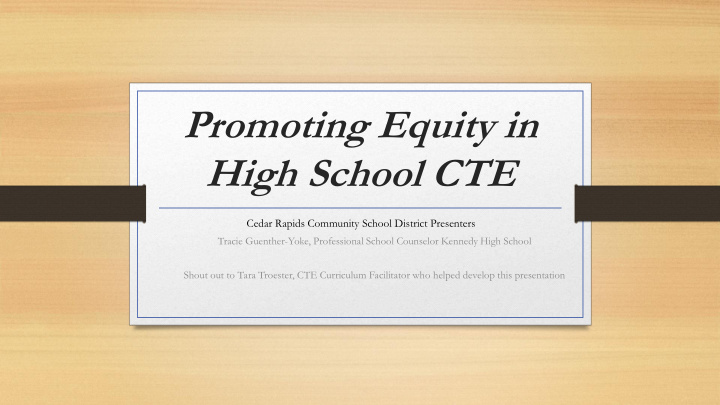



Promoting Equity in High School CTE Cedar Rapids Community School District Presenters Tracie Guenther-Yoke, Professional School Counselor Kennedy High School Shout out to Tara Troester, CTE Curriculum Facilitator who helped develop this presentation
Objectives • Learn about Cedar Rapids Community School District’s collaboration with the National Alliance for Partnerships in Equity (NAPE) • Learn about CRCSD specific projects from PIPE’s action research • Reflect on possible uses in your classroom/building/district
Career Activity • In the time given, list as many careers as possible for the gender identified on your group’s paper. • Switch papers and add to the careers. • Share Out
NAPE Vision: every person is able to fulfill their potential through equal access to and equity in educational options that lead to the entire spectrum of career choices National Alliance for Partnerships in Equity • Data Dashboards • Tool Kits • Program Improvement Process for Equity • Explore Nontraditional Careers/Nontraditional Career Preparation • Realizing Potential With Mindset
Program Improvement Process for Equity in 5 steps Step 1: Organize Organize 1. Assemble leadership team 2. Schedule training sessions 3. Collect student data 4. Measure the results
District Implementation of PIPE • High School Teams • Administrator • CTE Teacher (s) • Counselor • Middle School Counselors • Community College Partners
Step 2: Explore The data is VERY motivating!!! Explore 1. Analyze data and explore differences 2. Identify participation gaps 3. Expand the ‘why’: 4. Moral, economic and business case - https://hbr.org/2016/11/why-diverse- teams-are-smarter or https://hbr.org/2016/11/why-diverse-teams-are- smarter
Step 3: Discover Discover 1. Review research on root causes 2. Develop a hypothesis 3. Identify the root causes of the gaps
Step 4: Select We identified strategies within each of the five root cause areas: Education Family Career Information Internal / individual Societal
Step 5: Act
Program Improvement Process for Equity in Action: Media • What message is being received? • Does it encourage participation?
Intentional and Targeted Practices • Early Intervention was a top root cause • K-Navigator, Naviance, Career Cruising Systems • Job Shadows • Business Tours • Girl's Project Based Learning Day -these all lend themselves to role model/stereotype root cause
CTE Exposure • Of- campus efforts around tours, job shadowing, internships • Videos • “Cruise” and other means of direct exposure to programming Example: • https://www.youtube.com/watch?v=yNRWLETDItM
Telling Our Story • Be visible • Share • Collaborate with stakeholders • https://www.youtube.c om/watch?v=Wx- eKfGxppA
We CAN interrupt the cycle! You have the power to increase access and success for students in nontraditional programs by interrupting the cycle of negative micromessaging, bolstering self-efficacy and challenging cultural/gender stereotypes Step 1: examine own bias and cultural understanding Implicit bias activities: https://implicit.harvard.edu/implicit/
Ongoing Work • Curricular: ensuring Equity in Innovation and Problem-Based Learning • https://www.youtube.com/watch?v=UBMUKzFt0fk • Realizing Potential with Mindset and self-efficacy
Additional NAPE Resources • NAPE: https://www.napequity.org/ • Kudo Cards • Implicit bias • Check out these amazing Youtube Videos: • The Danger of the Single Story • What Does my Headscarf Mean to You • Whistling Vivaldi: How Stereotypes Affect Us and What We Can Do by Claude Steele
Recommend
More recommend